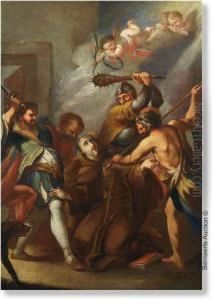Joseph Ignaz Wegscheider Paintings
Joseph Ignaz Wegscheider was a noted German painter and engraver, born on April 28, 1777, in the town of Lauterbach, Hesse. His artistic journey began in the late 18th century, a time when the art world was witnessing the transition from Rococo to Neoclassicism. Wegscheider's early education and influences in art are not extensively documented, but it is known that he developed a strong foundation in the classical traditions, which were pivotal in shaping his artistic style.
Wegscheider's career unfolded during a period of significant political and social change in Europe, including the French Revolution and the Napoleonic Wars. His work, however, remained primarily focused on religious themes, portraits, and occasionally historical subjects. His style was characterized by precision and attention to detail, a feature that made his engravings particularly noteworthy.
Not much is known about Wegscheider's personal life or his patrons, but like many artists of his era, he likely worked on commissions for churches, nobility, and affluent members of society who sought to preserve their likenesses and status through portraiture. Wegscheider's religious works would have been influenced by the Catholic Church, which was a significant patron of the arts, especially in the predominantly Catholic regions of Germany.
Joseph Ignaz Wegscheider's contributions to German art were recognized in his time, but he did not gain the same level of international fame as some of his contemporaries. Despite this, his works remain a testament to the craftsmanship and artistic values of his time. He passed away on January 11, 1853, in the city of Bamberg, Bavaria. Today, Wegscheider's legacy is preserved in the collections of various museums and through the continued appreciation of his engravings and paintings by art historians and enthusiasts.
